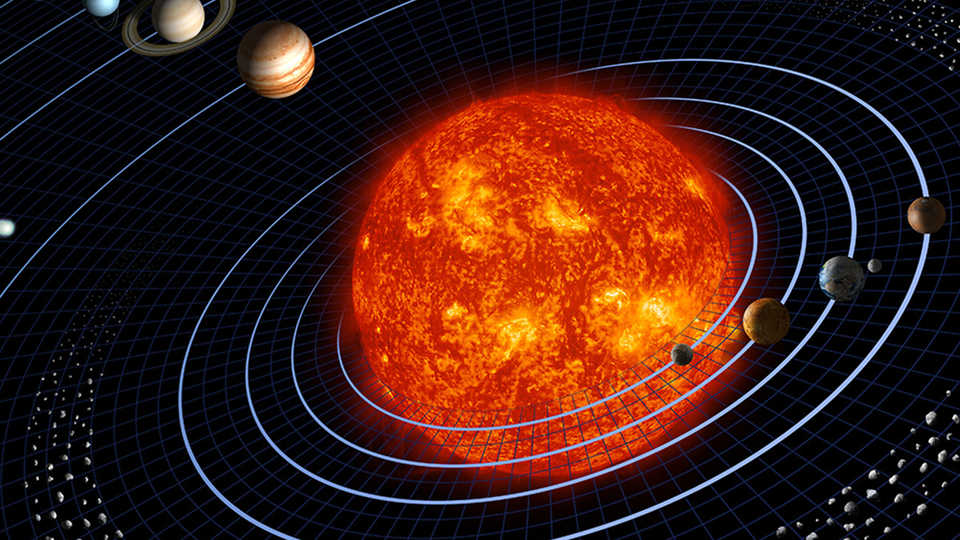Students will be able to:
- describe the relative distances between the orbits of the planets.
- recognize that objects in the solar system are very far from each other.

"Solar System" © 2005 NASA-JPL
How much space is in space? Students build a simple model and practice fractions to see how much space exists between different objects in our solar system.
Students will be able to:
For any scale model activity, it is useful to start by exploring the notion of models. Playthings, such as dolls or toy cars, can be a useful reference for talking about scale models.
Pull out a folded, completed sample of the model from your pocket. Point out that the planets never appear in a straight line like this in order out from the Sun, but this is just a reminder of the radius of the orbits. The planets would be found somewhere along a circle this far from the Sun. If you have a board with a thumbtack, you can tack it to the board at the Sun and show or draw out the orbits.
At the end of the discussion, be sure to have everyone put their names on their tapes and fold them up to put it in their pockets. But before you put them away, here are some questions you might ask to get participants thinking about insights they can get from building this model.
[Calculations: A light year, the distance light travels in one year, is about 63,240 AU (about 9,460,000,000,000 km). The nearest star is Proxima Centauri (visible from the Southern Hemisphere), at 4.2 light years. So, 4.2 ly x 63,240 AU/ly x 1 m/ 40 AU = 6640.2 m = about 7 km.]
Models and illustrations of the Solar System often misrepresent the true scales and distances involved. The difficulty lies in the vast difference between the relative sizes of these objects and the distance between them. For example, an accurate model using a 1” sphere to represent the Sun results in a distance to Pluto of over 350 feet (more than a football field away), and most of the planets would appear no larger than tiny specks.
It is usually beneficial to address these two dimensions separately, using one model to compare planet sizes and another to illustrate relative distances from the Sun. By combining this activity with the activity “Worlds in Comparison”, teachers can address the misconceptions prevalent in our depictions of the Solar System.
Distances in the solar system are difficult even for astronomers to picture, as they are far beyond our normal experience on Earth. For example, the distance from Earth to the Sun is about 93 million miles – to travel an equivalent distance on Earth, you would need to circle the globe 3,700 times! For the inner planets, the distances to the Sun are similar, ranging from ½ to 1 ½ times that of Earth, but the outer planets are much, much farther away – a fact that is often glossed over in textbook illustrations. This activity creates a simple model that more accurately illustrates the distances to planetary orbits relative to each other.
One way to think about these concepts is to compare the relative distances of the other planets from the Sun to that of the Earth. Astronomers use the mean distance of the Earth to the Sun as a standard unit, called an astronomical unit, or AU. Using this standard, the approximate average distances for each of the planets (and some dwarf planets) are:
This lesson was originally developed by Amie Gallagher, Raritan Valley Community College, and adapted by Suzanne Gurton and Anna Hurst, Astronomical Society of the Pacific, 2008.
Middle School
MS-ESS1-2: Develop and use a model to describe the role of gravity in the motions within galaxies and the solar system
MS-ESS1-3: Analyze and interpret data to determine scale properties of objects in the solar system
This lesson was originally developed by Amie Gallagher, Raritan Valley Community College, and adapted by Suzanne Gurton and Anna Hurst, Astronomical Society of the Pacific, 2008.
Image: "Solar System" by NASA-JPL, originally sourced from https://commons.wikimedia.org/wiki/File:Solar_sys.jpg